Metamorphic Ages of the Jurassic Accretionary Complexes in the Kanto Mountains, Central Japan, Determined by K–Ar Dating of Illite: Implications for the Tectonic Relationship between the Chichibu and Sanbagawa Belts
Abstract
:1. Introduction
2. Outline of Geology

3. Samples
4. Analytical Methods
5. Results
5.1. K–Ar Ages
5.1.1. Chert and Red Shale
5.1.2. Mudstone and Tuff
5.2. Illite Crystallinity
5.3. Mechanical Crushing Test
6. Discussion
6.1. Interpretation of K–Ar Ages
6.1.1. Chert and Red Shale
6.1.2. Mudstone and Tuff
6.1.3. Peak Metamorphic Ages
6.2. Tectonic Evolution of the Sanbagawa–Chichibu Belts
6.2.1. Subduction of the Ancient Mikabu Seamount
6.2.2. Comparison with Chronological Data in Central Shikoku
7. Conclusions
- The whole-rock and illite mineral ages of chert and red shale showed large variations. Overall, the K–Ar ages of chert and red shale were significantly older than those of mudstone, acidic tuff, and basic tuff in the same stratigraphic units, although pelagic materials of chert and red shales were almost free of detrital mica. Thus, it is possible that the K–Ar ages of chert and red shale reflect hydrothermal activities on the sea floor before subduction.
- The fractionated illite samples of chert, red shale, mudstone, acidic tuff, and basic tuff displayed older ages for larger grain sizes. The observed changes in CI can be explained by the formation of illite–smectite mixed-layer clays during retrograde stages, rather than contamination with detrital mica. The illite K–Ar ages of the largest grain size class (3–4 m) obtained from mudstone and tuff likely represent the peak metamorphic ages.
- Based on the K–Ar dating of mudstone, acidic tuff, and basic tuff, the peak metamorphic age of the Kashiwagi Unit was estimated as 117–110 Ma (Early Cretaceous), and a similar age (113 Ma) was obtained for an acidic tuff sample taken from the type locality of the Mikabu Greenstones. Hence, the Mikabu Greenstones can be considered as constituents of the Kashiwagi Unit in the Northern Chichibu Belt.
- Among the Middle Jurassic accretionary complexes, the lower structural unit (Manba Unit) yielded a peak metamorphic age in the Early Cretaceous (132–107 Ma); whereas the upper structural unit (Kamiyoshida Unit) showed apparently older ages in the Late Jurassic (163–144 Ma). As such, the lower part of the Manba Unit can be interpreted as a re-worked part of the Middle Jurassic accretionary complex, which acted as a shadow zone of the subducting Mikabu seamount. The discontinuity in the peak metamorphic age between the Manba and Kamiyoshida Units supports the post-metamorphic nappe model proposed by Shimizu [36].
Author Contributions
Funding
Data Availability Statement
Acknowledgments
Conflicts of Interest
Appendix A. List of Samples
| Sample | Geologic Unit | Rock Type | Locality |
|---|---|---|---|
| 26-01A * | Manba Unit | acidic tuff | Kashiwagi |
| 26-01B * | Manba Unit | mudstone | Kashiwagi |
| 26-03 | Kashiwagi Unit | acidic tuff | Kashiwagi |
| 26-04 | Manba Unit | mudstone | Syouri |
| 26-05 | Manba Unit | chert | Syouri |
| 27-01 | Manba Unit | mudstone | Kuroda |
| 27-02 | Kamiyoshida Unit | chert | Kuroda |
| 27-03 | Kamiyoshida Unit | chert | Kuroda |
| 27-04 | Manba Unit | basic tuff | Kodaira |
| 27-05 | Kashiwagi Unit | acidic tuff | Kodaira |
| 27-06 | Kashiwagi Unit | mudstone | Kodaira |
| 27-07 | Kashiwagi Unit | red shale | Aonashi |
| 27-08 | Kashiwagi Unit | red chert | Aonashi |
| 27-10 | Manba Unit | chert | Kodaira |
| 27-11 | Manba Unit | mudstone | Kodaira |
| 27-12A | Manba Unit | sandstone | Kodaira |
| 27-12B | Manba Unit | chert | Kodaira |
| 28-01 | Mikabu Greenstones | red shale | Mt. Nishi-Mikaboyama (NM) |
| 28-02 | Unknown | chert | Akiba-touge pass |
| 28-03A | Manba Unit | chert | Asou |
| 28-03B | Manba Unit | chert | Asou |
| 28-04 | Manba Unit | mudstone | Asou |
| L-7 | Kashiwagi Unit | acidic tuff | Aonashi |
| L-11 | Kamiyoshida Unit | mudstone | Tsuchisaka-touge pass |
| L-13 | Kamiyoshida Unit | mudstone | Tsuchisaka-touge pass |
| Mi-10 | Mikabu Greenstones | acidic tuff | Mt. Odokeyama (OD) |
References
- Banno, S. The high-pressure metamorphic belts of Japan: A review. J. Soc. Am. Mem. 1986, 164, 365–385. [Google Scholar]
- Faure, M.; Charvet, J. Tangential tectonics in the Chichibu zone from the example of E. Shikoku. Proc. Japan Acad. 1983, 59, 117–120. [Google Scholar] [CrossRef] [Green Version]
- Faure, M. The pre-Cretaceous structure of the Outer belt of southwest Japan. Tectonophysics 1985, 113, 139–162. [Google Scholar] [CrossRef]
- Faure, M.; Caridroit, M.; Charvet, J. The Late Jurassic oblique collisional orogen of SW Japan. Tectonics 1986, 5, 1089–1114. [Google Scholar] [CrossRef] [Green Version]
- Guidi, A.; Charvet, J.; Sato, T. Finding of granitic olistolith and pre-Cretaceous radiolarians in the northwestern Kanto Mountains, Gunma Prefecture, Central Japan. J. Geol. Soc. Jap. 1984, 90, 853–856. [Google Scholar] [CrossRef] [Green Version]
- Guidi, A.; Charvet, J.; Sato, T.; Takizaka, S. Pre-Cretaceous tangential structures in the Kanto Mountains, (SW Japan): Preliminary results. Bull. Soc. Geól. Fr. 1984, 298, 307–312, (In French with English abstract). [Google Scholar]
- Guidi, A.; Charvet, J. A new structural interpretation of the Kanto Mountains, northern-west of Tokyo, Japan. Bull. Soc. Geól. Fr. 1987, 8, 843–853. [Google Scholar] [CrossRef]
- Itaya, T.; Takasugi, H. Muscovite K-Ar ages of the Sanbagawa Schists, Japan and Argon depletion during cooling and deformation. Contrib. Mineral. Petrol. 1988, 100, 281–290. [Google Scholar] [CrossRef]
- Takasu, A.; Dallmeyer, R.D. 40Ar/39Ar mineral age constraints for the tectonothermal evolution of the Sanbagawa metamorphic belt, central Shikoku, Japan: A Cretaceous accretionary prism. Tectonophysics 1990, 185, 111–139. [Google Scholar] [CrossRef]
- Dallmeyer, R.D.; Takasu, A.; Yamaguchi, K. Mesozoic tectonothermal development of the Sanbagawa, Mikabu and Chichibu belts, South-west Japan: Evidence from 40Ar/39Ar whole-rock phyllite ages. J. Metamorph. Geol. 1995, 13, 271–286. [Google Scholar] [CrossRef]
- Isozaki, Y.; Itaya, T. Chronology of Sanbagawa metamorphism. J. Metamorph. Geol. 1990, 8, 401–411. [Google Scholar] [CrossRef]
- Kawato, K.; Isozaki, Y.; Itaya, T. Geotectonic boundary between the Sanbagawa and Chichibu belts in central Shikoku, Southwest Japan. J. Geol. Soc. Jap. 1991, 97, 959–975, (In Japanese with English abstract). [Google Scholar] [CrossRef]
- Isozaki, Y.; Maruyama, S. Studies on Orogeny based on plate tectonics in Japan and new geotectonic subdivision of the Japanese islands. J. Geogr. (Chigaku Zassi) 1991, 100, 697–761, (In Japanese with English abstract). [Google Scholar] [CrossRef]
- Isozaki, Y. Jurassic accretion tectonics of Japan. Isl. Arc 1997, 6, 25–51. [Google Scholar] [CrossRef]
- Aoki, K.; Seo, Y.; Sakata, S.; Obayashi, H.; Tsuchiya, Y.; Imayama, T.; Yamamoto, S.; Hirata, T. U–Pb zircon dating of Sanbagawa metamorphic rocks in the Besshi–Asemi-gawa region, central Shikoku, Japan, and tectonostratigraphic consequences. J. Geol. Soc. Jap. 2019, 125, 183–194. [Google Scholar] [CrossRef] [Green Version]
- Knittel, U.; Walia, M.; Suzuki, S.; Lee, Y.H. U-Pb single grain zircon ages for Sanbagawa Metamorphic Rocks in central Shikoku (Japan): The Sanbagawa Belt re-united. Okayama Univ. Earth Sci. Rep. 2018, 25, 39–48. [Google Scholar]
- Knittel, U.; Walia, M.; Suzuki, S.; Lee, Y.H. Late Cretaceous age of eclogite facies metamorphism of the Sanbagawa belt in the Asemi River area, Shikoku (SW Japan): Evidence from detrital zircon. J. Asian Earth Sci. 2019, 77, 48–51. [Google Scholar] [CrossRef]
- Koto, B. On the so-called crystalline schists of Chichibu. J. Coll. Sci. Imp. Univ. 1988, 2, 77–141. [Google Scholar]
- Endo, S.; Wallis, S.R. Structural architecture and low-grade metamorphism of the Mikabu-Northern Chichibu accretionary wedge, SW Japan. J. Metamorph. Geol. 2017, 35, 695–716. [Google Scholar] [CrossRef]
- Miyashita, A.; Itaya, T. K-Ar age and chemistry of phengite from the Sanbagawa schists in the Kanto Mountains, central Japan, and their implication for exhumation tectonics. Gondwana Res. 2002, 5, 837–848. [Google Scholar] [CrossRef]
- Suzuki, S.; Ishizuka, H. Low-grade metamorphism of the Mikabu and northern Chichibu belts in central Shikoku, SW Japan: Implications for the areal extent of the Sanbagawa low-grade metamorphism. J. Metamorph. Geol. 1998, 16, 107–116. [Google Scholar] [CrossRef]
- Shimizu, I.; Yoshida, S. Strain geometries in the Sanbagawa Metamorphic Belt inferred from deformation structures in metabasite. Isl. Arc 2004, 13, 95–109. [Google Scholar] [CrossRef]
- Ozawa, H.; Motoyama, S.; Inoue, S.; Kato, Y.; Murata, M. Petrology of basic volcanics of the Mikabu greenstone complex in the eastern Shikoku. Mem. Geol. Soc. Japan 1999, 52, 217–228, (In Japanese with English abstract). [Google Scholar]
- Tominaga, K.; Hara, H. Paleogeography of Late Jurassic large-igneous-province activity in the Paleo-Pacific Ocean: Constraints from the Mikabu greenstones and Chichibu accretionary complex, Kanto Mountains, Central Japan. Gondwana Res. 2021, 89, 177–192. [Google Scholar] [CrossRef]
- Ozawa, H.; Murata, M.; Itaya, T. Early Jurassic volcanism of the Mikabu belt: Evidence from K-Ar age of picritic basalt, Kurouch ultramafic mass, Kanto Mountains, Japan. J. Geol. Soc. Jap. 1997, 103, 1089–1092. [Google Scholar] [CrossRef]
- Sawada, H.; Isozaki, Y.; Aoki, S.; Sakata, S.; Sawaki, Y.; Hasegawa, R.; Nakamura, Y. The late Jurassic magmatic protoliths of the Mikabu greenstones in SW Japan: A frag- ment of an oceanic plateau in the Paleo-Pacific Ocean. J. Asian Earth Sci. 2019, 169, 228–236. [Google Scholar] [CrossRef]
- Watanabe, T. K–Ar ages of white mica fraction from the Susunai metamorphic rocks in Sakhalin, Far East Russian. Fac. Sci. Hokkaido Univ. Ser. 1992, 23, 282–286. [Google Scholar]
- Hirajima, T.; Isono, T.; Itaya, T. K-Ar age and chemistry of white mica in the Sanbagawa metamorphic rocks in the Kanto Mountains, Central Japan. J. Geol. Soc. Jap. 1992, 98, 445–455. [Google Scholar] [CrossRef] [Green Version]
- Takami, M.; Isozaki, Y.; Nishimaru, Y.; Itaya, T. Effect of detrital white mica and contact metamorphism to K-Ar dating of weakly metamorphosed accretionary complex—An example of Jurassic accretionary complex in eastern Yamaguchi Prefecture, Southwest Japan. J. Geol. Soc. Jap. 1993, 99, 545–563, (In Japanese with English abstract). [Google Scholar] [CrossRef]
- Hueck, M.; Wemmer, K.; Ksienzyk, A.; Kuehn, R.; Vogel, N. Potential, premises, and pitfalls of interpreting illite argon dates—A case study from the German Variscides. Earth-Sci. Rev. 2022, 232, 104133. [Google Scholar] [CrossRef]
- Kübler, B. La cristallinité de l‘illite et les zones tout a fait superieures du métamorphisme. In Étages Tectoniques: Colloque de Neuchâtel; Université de Neuchâtel: Neuchâtel, Switzerland, 1967; pp. 105–121. [Google Scholar]
- DiTullio, L.; Laughl, M.M.; Byrne, T. Thermal maturity and constraints on deformation from illite crystallinity and vitrinite reflectance in the shallow levels of an accretionary prism: Eocene-Oligocene Shimanto Belt, southwest Japan. Geol. Soc. Am. Spec Pap. 1993, 273, 63–82. [Google Scholar]
- Awan, M.A.; Kimura, K. Thermal structure and uplift of the Cretaceous Shimanto Belt, Kii Peninsula, Southwest Japan: An Illite crystallinity and illite b0 lattice spacing study. Isl. Arc 1996, 5, 69–88. [Google Scholar] [CrossRef]
- Hara, H.; Hisada, K.; Kimura, K. Paleo-geothermal structure based on illite crystallinity of the Chichibu and Shimanto Belts in the Kanto Mountains, central Japan. J. Geol. Soc. Jap. 1998, 104, 705–717. [Google Scholar] [CrossRef]
- Hara, H.; Kimura, K. Estimation of errors in measurement of illite crystallinity: The limits and problems of application to accretionary complexes. J. Geol. Soc. Jap. 2000, 106, 264–279, (in Japanese with English abstract). [Google Scholar] [CrossRef] [Green Version]
- Shimizu, I. Ductile deformation in the low-grade part of the Sambagawa metamorphic belt in the Kanto Mountains, Central Japan. J. Geol. Soc. Jap. 1988, 94, 609–628. [Google Scholar] [CrossRef] [Green Version]
- Okubo, M.; Horiguchi, M. Geology of the Mamba District; Quadrangle Series, 1:50,000; Geological Survey of Japan: Tsukuba, Japan, 1969; 66p. (In Japanese) [Google Scholar]
- Sato, T.; Kakizawa, S.; Kodato, T. Revision of stratigraphy and structure of the Sakahara Formation at its type locality. J. Geol. Soc. Jap. 1977, 83, 631–637, (In Japanese with English abstract). [Google Scholar] [CrossRef]
- Sekine, K.; Iijima, H.; Saito, Y. Jurassic Radiolarians from the low-grade metamorphic zone of the northern part of the Chichibu Belt, Kanto Mountains, Central Japan. Bull. Natl. Sci. Mus. Ser. C 2001, 27, 101–108. [Google Scholar]
- Matsuoka, K. Late Jurassic radiolarians from the northern subbelt of the Chichibu Belt in Ogawa town, Saitama Prefecture, Central Japan. Earth Sci. (Chikyu Kagaku) 1996, 50, 251–255. (In Japanese) [Google Scholar]
- Matsuoka, A.; Yamakita, S.; Sakakibara, M.; Hisada, K. Unit division for the Chichibu Composite Belt from a view point of accretionary tectonics and geology of western Shikoku, Japan. J. Geol. Soc. Jap. 1998, 104, 634–653, (In Japanese with English abstract). [Google Scholar] [CrossRef]
- Sashida, K.; Igo, H.; Igo, H.; Kakizawa, S.; Hisada, K.; Shibata, T.; Tsukada, K.; Nishimura, H. On the Jurassic radiolarian assemblages in the Kanto district. News Osaka Micropaleontol. Spec. 1982, 5, 51–64, (In Japanese with English abstract). [Google Scholar]
- Kamikawa, Y.; Hisada, K.; Sashida, K.; Igo, H. Geology of the Nanmoku area in the Chichibu Terrane, the northwest part of the Kanto Mountains, central Japan. Sci. Rep. Inst. Geosci. Tsukuba Ser. B 1997, 18, 19–38. [Google Scholar]
- Sekine, K.; Iijima, H.; Saito, Y. Jurassic radiolarians from the Manba Unit of the Northern Chichibu Belt, Kanto Mountains, Japan. Bull. Natl. Sci. Mus. Ser. C 1995, 21, 1–10. [Google Scholar]
- Iijima, H.; Sekine, K.; Saito, Y. Jurassic Radiolarians from the clastic rock unit of the northern part of the Chichibu Belt, Kanto Mountains, Central Japan. Bull. Natl. Sci. Mus. Ser. C 1993, 19, 81–89. [Google Scholar]
- Iijima, H.; Sekine, K.; Saito, Y. Geologic age of the Kamiyoshida Unit of the Chichibu Belt, Kanto Mountains, Japan. Bull. Natl. Sci. Mus. Ser. C 1994, 22, 119–131. [Google Scholar]
- Uchida, N. Major-element petrochemistry of lavas and tuffs from the Sanbagawa and Chichibu terrane—The northern Kanto Mountains, Central Japan. Seikei Ronso 1981, 20, 1–138. [Google Scholar]
- Matsuoka, K. Late Jurassic radiolarians from red shale on the Mikabu greenstones in the northern margin of Kanto Mountains, Japan. Earth Sci. (Chikyu Kagaku) 1999, 53, 71–74. (In Japanese) [Google Scholar]
- Matsuoka, K. Discovery of Jurassic radiolarians from an unknown formation of the Northern subbelt of the Chichibu Belt in Manba town, Gumma Prefecture, Japan. Earth Sci. (Chikyu Kagaku) 1995, 49, 346–351. (In Japanese) [Google Scholar]
- Tominaga, K.; Hara, H.; Tokiwa, T. Zircon U–Pb ages of the Kashiwagi Unit of the accretionary complex in the Northern Chichibu Belt, Kanto Mountains, central Japan. Bull. Geol. Surv. Jpn. 2019, 70, 299–314, (In Japanese with English abstract). [Google Scholar] [CrossRef] [Green Version]
- Hirajima, T.; Banno, S. Records of high pressure metamorphism in the so-called “superficial nappe” in the Chichibu belt, Japan. Bull. Soc. Geól. France 1989, 3, 661–664. [Google Scholar] [CrossRef]
- Tagiri, M.; Hirajima, T.; Shimizu, I. Abukuma and Sanbagawa metamorphic belts in the Kanto district. In Guidebook of 29th IGC Field Trip C08; Nagoya University: Nagoya, Japan, 1992; pp. 63–93. [Google Scholar]
- Geospatial Information Authority of Japan, Digital Topographic Map 25000. Available online: https://maps.gsi.go.jp/vector/ (accessed on 29 July 2019).
- Hisada, K.; Tominaga, K.; Sekine, K.; Matsuoka, L.; Kato, K. Geology of the northern Chichibu belt in the Kanto Mountains, central Japan. J. Geol. Soc. Japan 2016, 122, 325–342. [Google Scholar] [CrossRef] [Green Version]
- Kanto Mountains Research Group. The northern subbelt of the Chichibu Belt along the Kanna River in the Kanto Mountains, Central Japan. Earth Sci. (Chikyu Kagaku) 1994, 48, 83–101. (In Japanese) [Google Scholar]
- Isozaki, Y.; Maruyama, S.; Aoki, K.; Nakama, T.; Miyashita, A.; Otoh, S. Geotectonic subdivision of the Japanese islands revisited: Categorization and definition of elements and boundaries of Pacific-type (Miyashiro-type) orogen. J. Geogr. (Chigaku Zassi) 2010, 119, 999–1053, (In Japanese with English abstract). [Google Scholar] [CrossRef] [Green Version]
- Itaya, T.; Nagao, K.; Inoue, K.; Honjou, Y.; Okada, T.; Ogata, A. Argon isotope analysis by newly developed mass spectrometric system for K-Ar dating. Miner. J. 1991, 15, 203–221. [Google Scholar] [CrossRef]
- Itaya, T.; Doi, M.; Ohira, T. Very low potassium analysis by flame photometry using ultra low blank chemical lines: An application of K-Ar method to ophiollites. Geochem. J. 1996, 30, 31–39. [Google Scholar] [CrossRef]
- Steiger, R.H.; Jäger, E. Subcommission on geochronology: Convention on the use of decay constants in geo- and cosmochronology. Earth Planet. Sci. Lett. 1977, 36, 359–362. [Google Scholar] [CrossRef]
- Jaboyedoff, M.; Bussy, F.; Kübler, B.; Thelin, P. Illite “crystallinity”revisited. Clays Clay Min. 2001, 49, 156–167. [Google Scholar] [CrossRef]
- Blenkinsop, T.G. Definition of low-grade metamorphic zones using illite crystallinity. J. Metamorphic Geol. 1988, 6, 623–636. [Google Scholar] [CrossRef]
- Kisch, H.J. Illite crystallinity: Recommendations on sample preparation, X-ray diffraction settings, and interlaboratory samples. J. Metamorph. Geol. 1991, 9, 665–670. [Google Scholar] [CrossRef]
- Warr, L.N.; Mählmann, R.F. Recommendations for Kübler index standardization. Clay Miner. 2015, 50, 283–286. [Google Scholar] [CrossRef]
- Underwood, M.B.; Laughl, M.M.; Kang, S.M. A comparison among organic and inorganic indicators of diagenesis and low-temperature metamorphism, Tertiary Shimanto Belt, Shikoku, Japan. Spec. Pap. Geol. Soc. Am. 1993, 273, 45. [Google Scholar]
- Hara, H.; Mori, H.; Tominaga, K.; Nobe, Y. Progressive low-grade metamorphism reconstructed from the Raman spectroscopy of Carbonaceous material and an EBSD analysis of quartz in the Sanbagawa metamorphic event, Central Japan. Minerals 2021, 11, 854. [Google Scholar] [CrossRef]
- Takasu, A.; Wallis, S.R.; Banno, S.; Dallmeyer, R.D. Evolution of the Sanbagawa metamorphic belt, Japan. Lithos 1994, 33, 119–133. [Google Scholar] [CrossRef]
- Dodson, M.H. Closure temperature in cooling geochronological and petrological system. Contrib. Min. Petrol. 1973, 40, 259–274. [Google Scholar] [CrossRef]
- Tagami, T. Thermochronological investigation of fault zones. Tectonophysics 2012, 538–540, 67–85. [Google Scholar] [CrossRef] [Green Version]
- Kubota, Y.; Takeshita, T.; Yagi, K.; Itaya, T. Kinematic analyses and radiometric dating of the large-scale paleogene two phase faulting along the median tectonic line, Southwest Japan. Tectonophysics 2020, 39, e2018TC005372. [Google Scholar] [CrossRef]
- Faure, M.; Iwasaki, M.; Ichikawa, K.; Yao, A. The significance of Upper Jurassic radiolarians in high pressure metamorphic rocks of SW Japan. J. Southeast Asian Earth Sci. 1991, 62, 131–136. [Google Scholar] [CrossRef]
- Tsutsumi, Y.; Miyashita, A.; Terada, K.; Hidaka, H. SHRIMP U–Pb dating of detrital zircons from the Sanbagawa Belt, Kanto Mountains, Japan: Need to revise the framework of the belt. J. Mineral. Petrol. Sci. 2009, 104, 12–24. [Google Scholar] [CrossRef] [Green Version]
- Aoki, K.; Iizuka, T.; Hidaka, T.; Maruyama, S.; Terabayashi, M. Tectonic boundary between the Sanbagawa belt and the Shimanto belt in central Shikoku, Japan. J. Geol. Soc. Jap. 2007, 113, 171–183. [Google Scholar] [CrossRef] [Green Version]
- Matsuoka, K. The Kashiwagi Unit if the Northern Chichibu Belt in the northeastern Kanto Mountains—Lithofacies, geologic age and oceanic plate stratigraphy. Earth Sci. (Chikyu Kagaku) 2013, 67, 101–112. [Google Scholar]
- Aoki, K.; Maruyama, S.; Isozaki, Y.; Otoh, S.; Yanai, S. Recognition of the Shimanto HP metamorphic belt within the traditional Sanbagawa HP metamorphic belt: New perspectives of the Cretaceous–Paleogene tectonics in Japan. J. Asian Earth Sci. 2011, 42, 355–369. [Google Scholar] [CrossRef]
- Aoya, M. Geology of the Hibihara district. In Outline of Geology; Quadrangle Series, 1:50,000; Geological Survey of Japan, AIST: Tokyo, Japan, 2009; Chapter 2; pp. 5–9. (In Japanese) [Google Scholar]
- Isozaki, Y.; Itaya, T.; Kawato, K. Metamorphic age of Jurassic accretionary complex in the Northern Chichibu belt, Southwest Japan. J. Geol. Soc. Jap. 1990, 96, 557–560, (In Japanese with English abstract). [Google Scholar] [CrossRef]
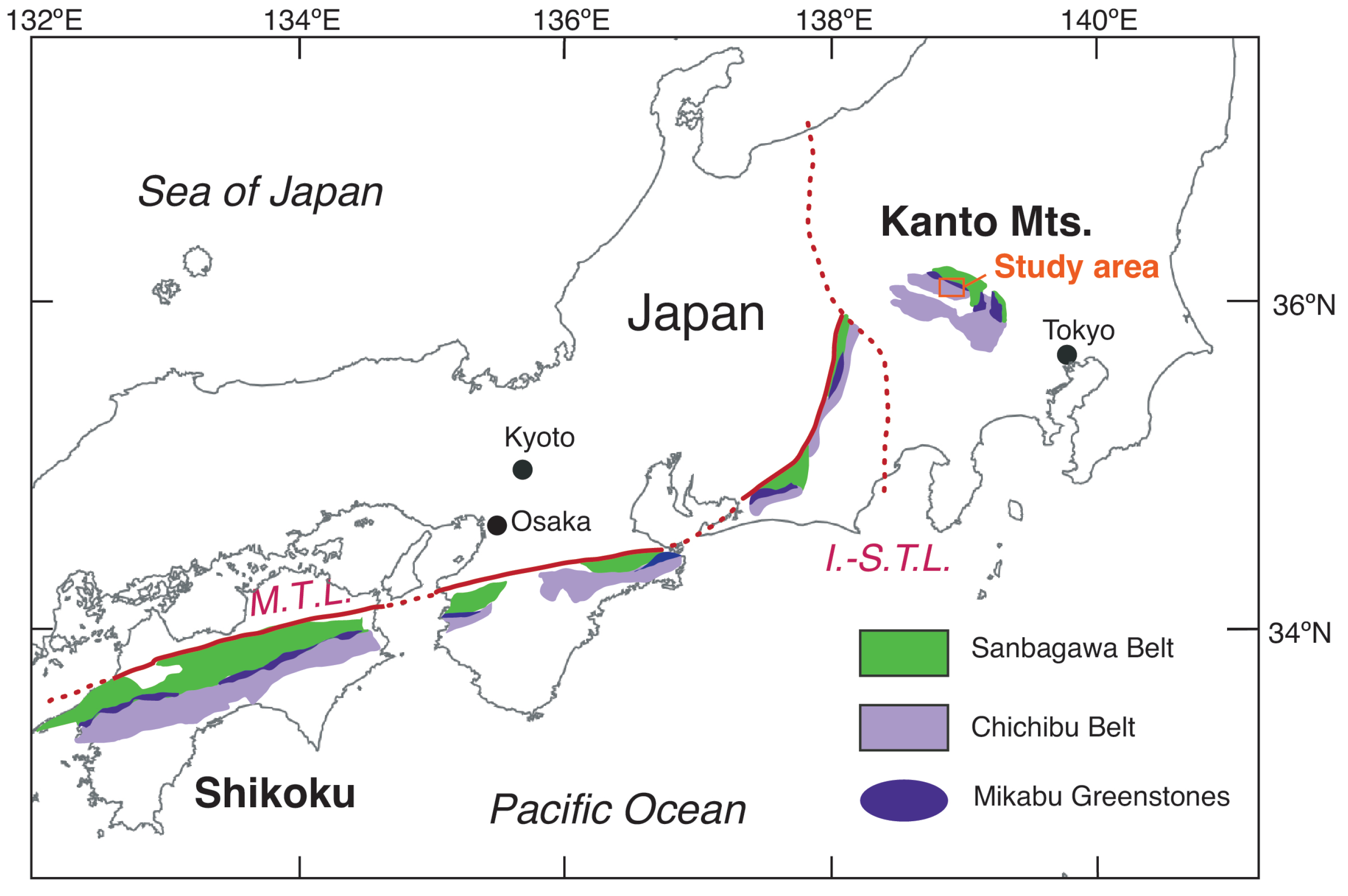
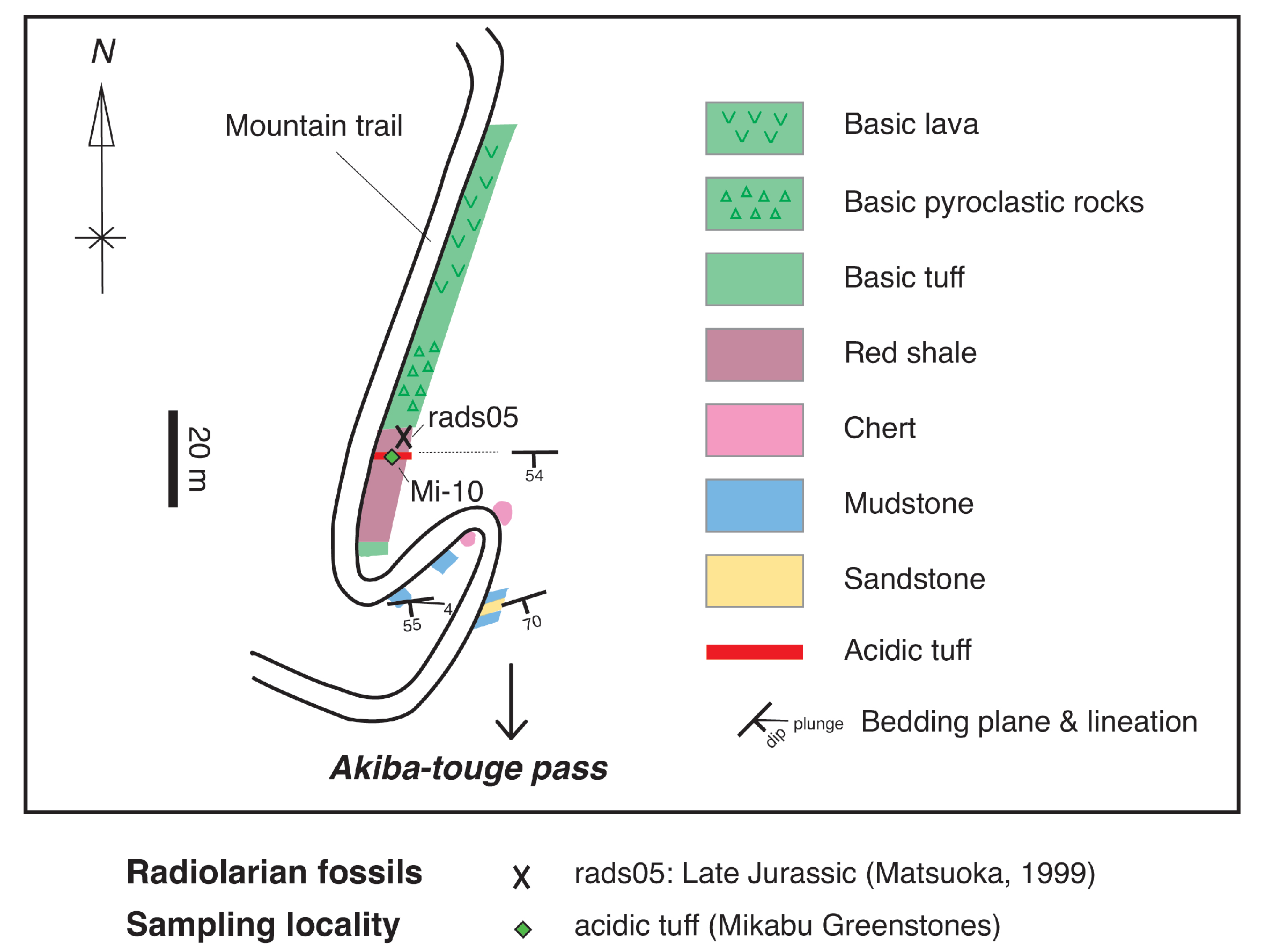
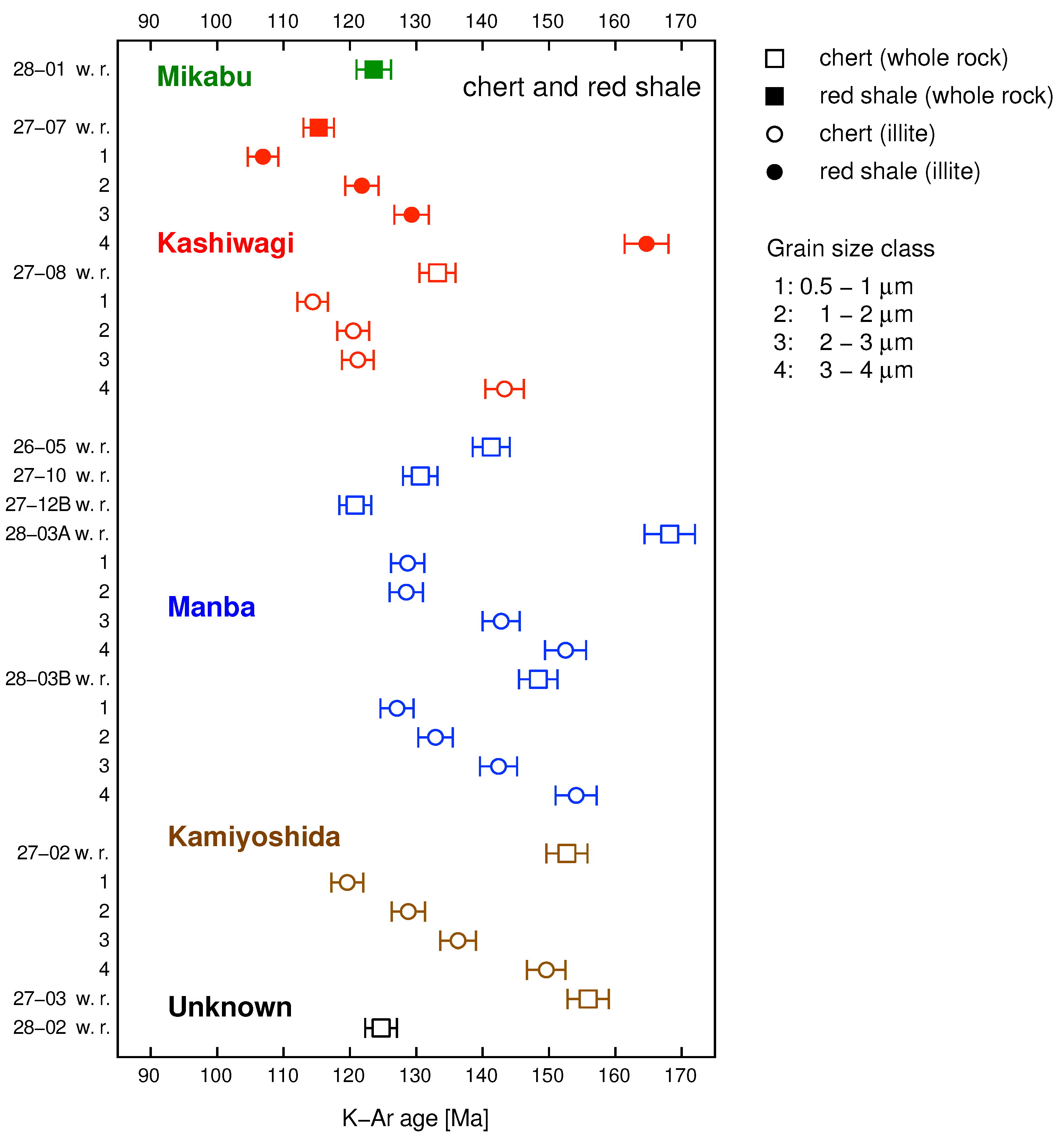
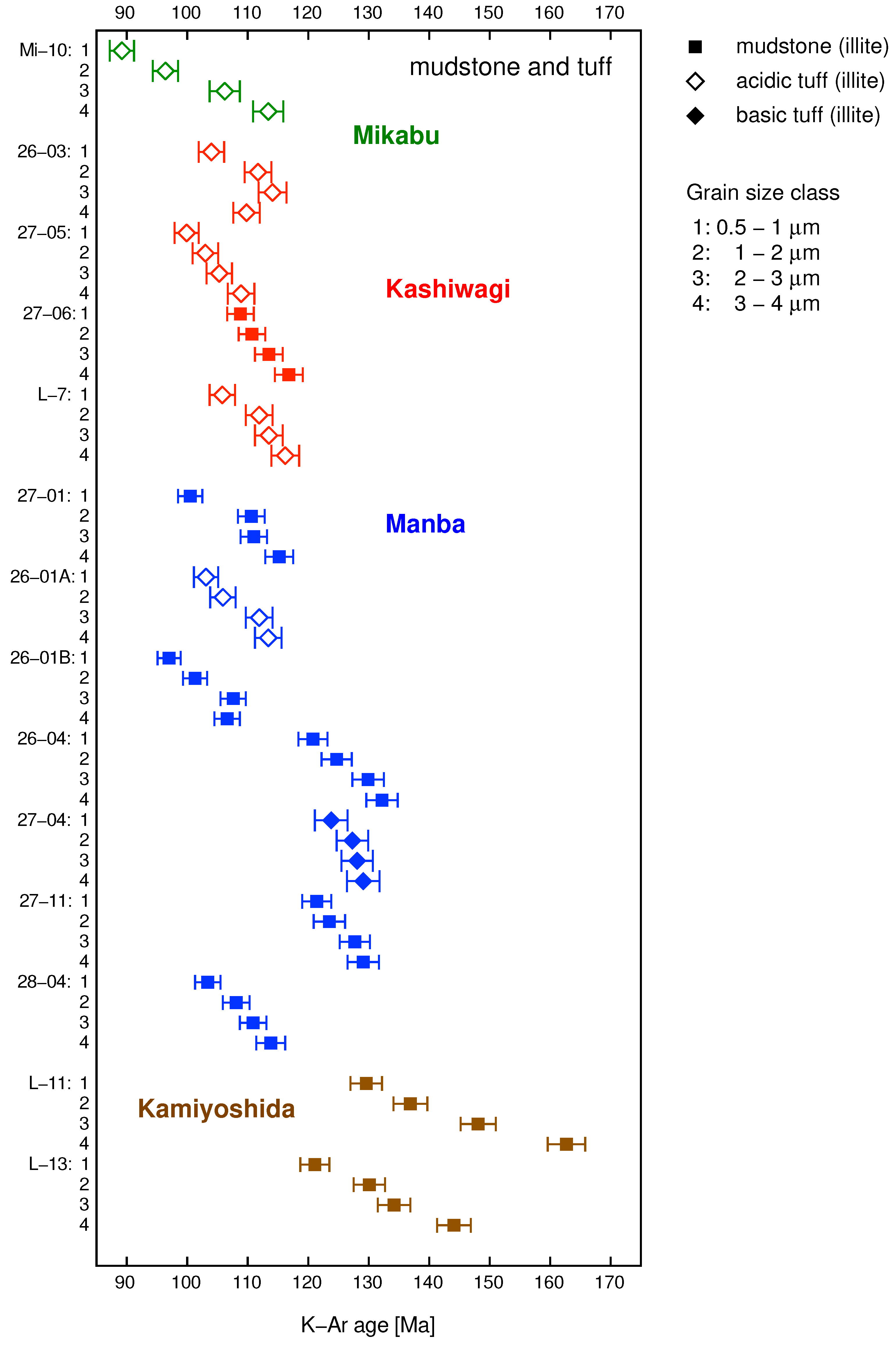

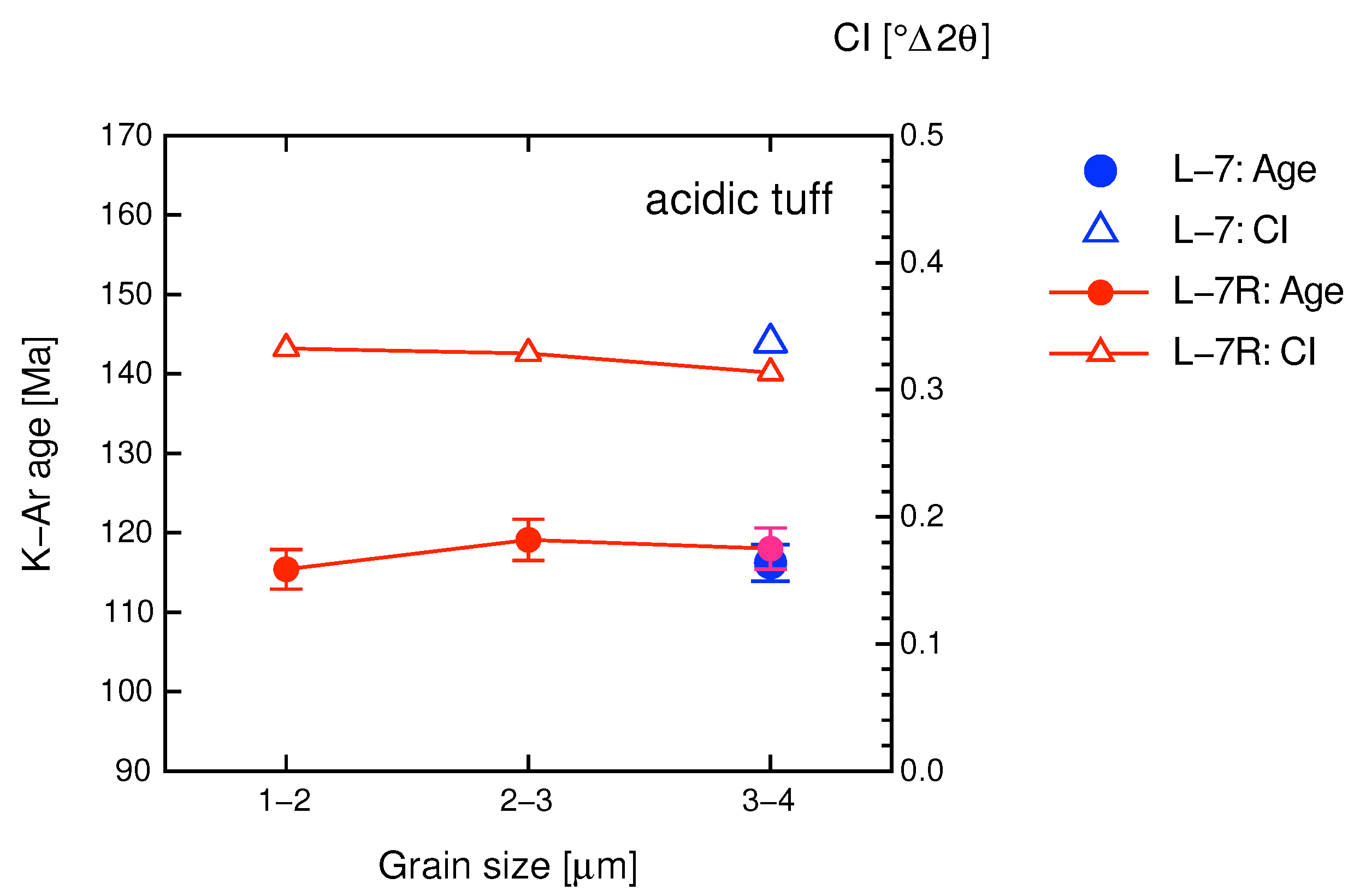
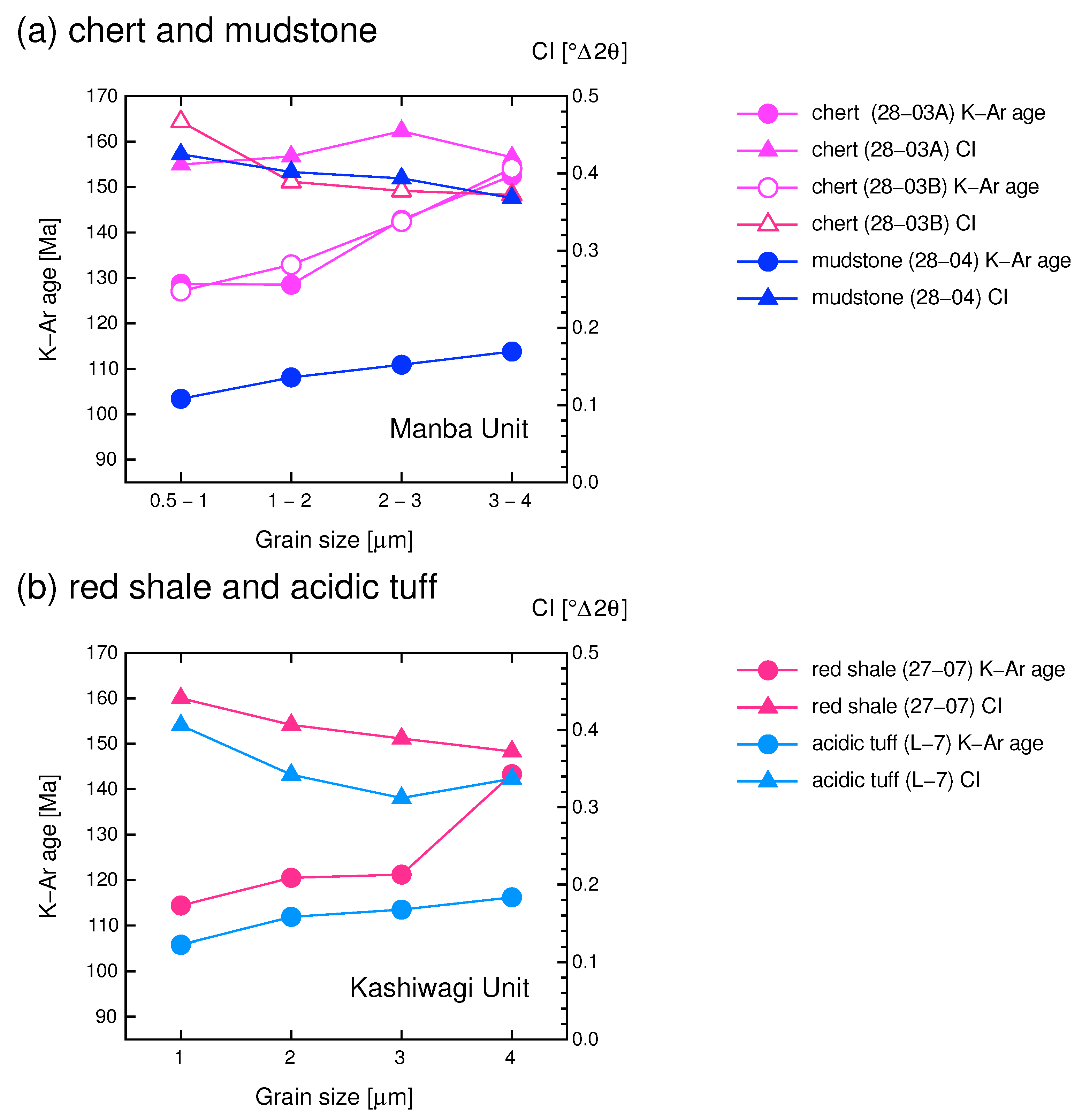
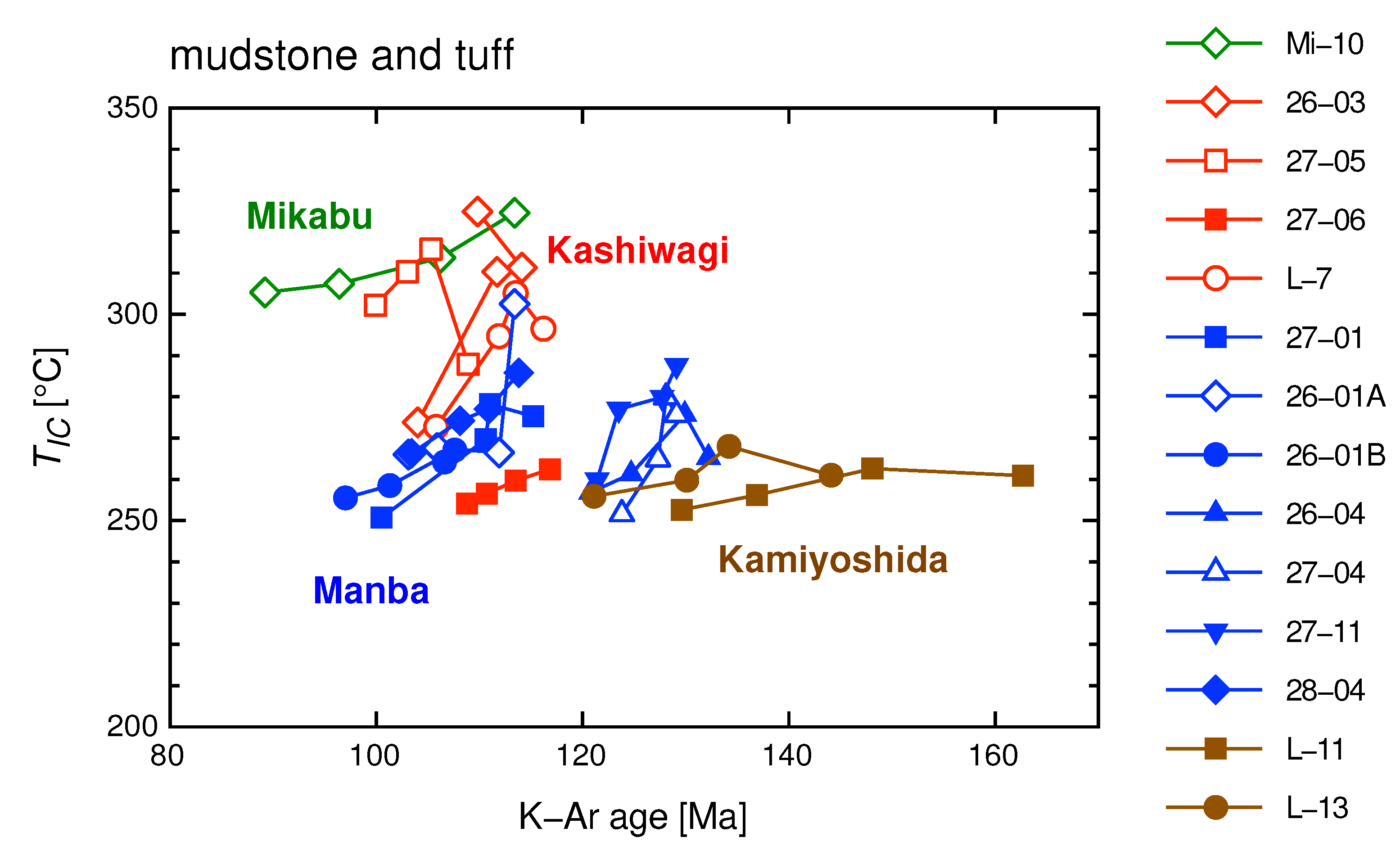
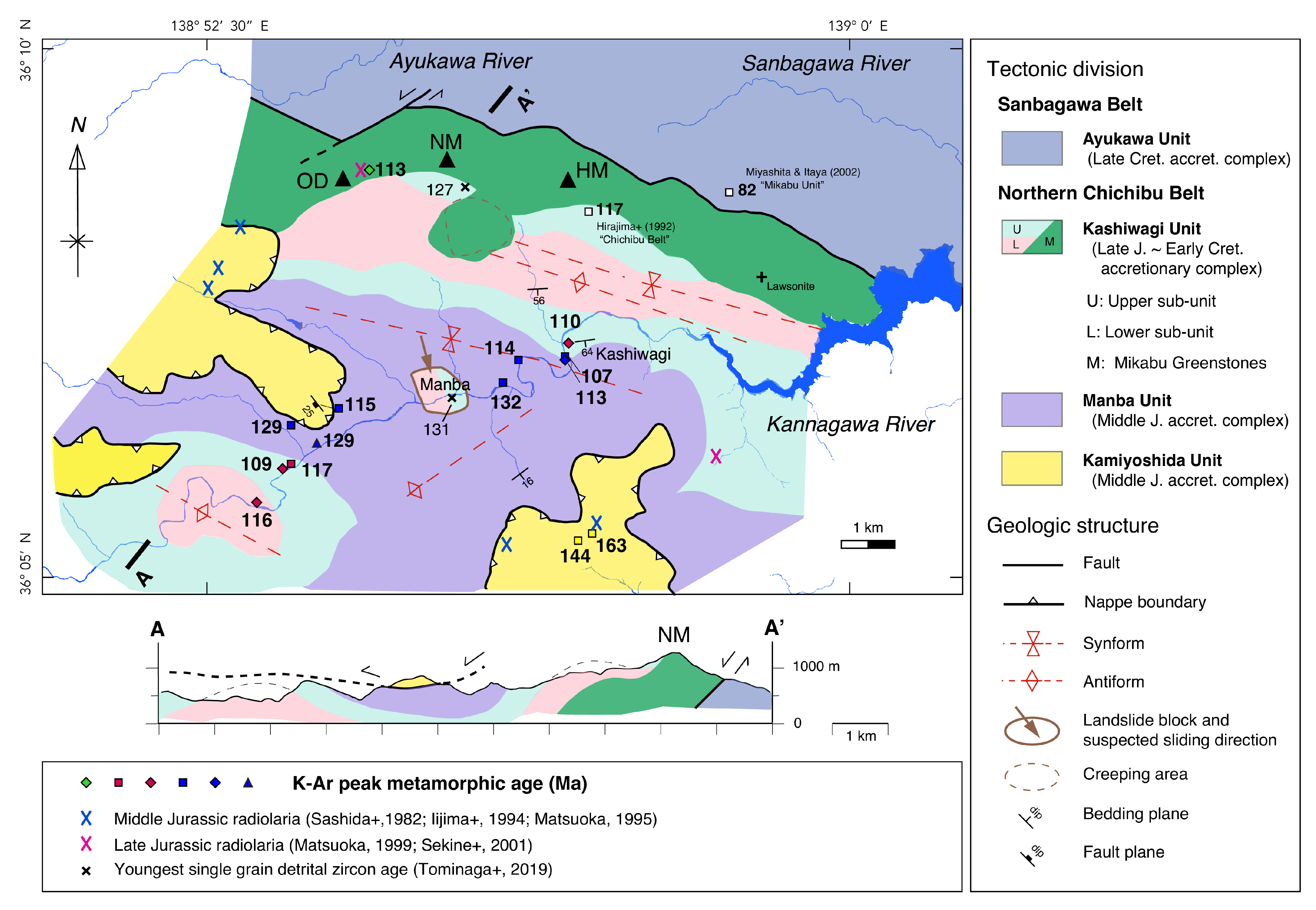

| Geologic Unit | Sample | Rock Type | Grain Size | K | Rad. Ar | Age | CI | |
|---|---|---|---|---|---|---|---|---|
| (m) | (wt.%) | (10 cc STP/g) | (Ma) | () | (C) | |||
| Mikabu Greenstones | 28-01 | red shale | whole rock | 0.43 ± 0.02 | 216 ± 2 | 123.6 ± 2.6 | ||
| Kashiwagi Unit | 27-07 | red shale | whole rock | 0.60 ± 0.02 | 277 ± 3 | 115.3 ± 2.3 | ||
| 0.5–1 | 6.03 ± 0.12 | 2641 ± 26 | 106.9 ± 2.3 | 0.474 | 249.2 | |||
| 1–2 | 5.26 ± 0.11 | 2574 ± 25 | 121.8 ± 2.5 | 0.452 | 257.1 | |||
| 2–3 | 3.46 ± 0.07 | 1978 ± 17 | 129.3 ± 2.6 | 0.456 | 255.7 | |||
| 3–4 | 1.95 ± 0.03 | 1304 ± 14 | 164.7 ± 3.3 | 0.422 | 267.4 | |||
| 27-08 | chert | whole rock | 0.14 ± 0.01 | 75 ± 1 | 133.2 ± 2.7 | |||
| 0.5–1 | 1.35 ± 0.03 | 617 ± 18 | 114.4 ± 2.3 | 0.441 | 260.6 | |||
| 1–2 | 1.46 ± 0.03 | 705 ± 15 | 120.5 ± 2.4 | 0.407 | 272.5 | |||
| 2–3 | 1.54 ± 0.03 | 747 ± 16 | 121.2 ± 2.4 | 0.389 | 278.6 | |||
| 3–4 | 1.09 ± 0.02 | 632 ± 8 | 143.3 ± 2.9 | 0.372 | 284.3 | |||
| Manba Unit | 26-05 | chert | whole rock | 0.17 ± 0.01 | 94 ± 1 | 141.3 ± 2.8 | ||
| 27-10 | chert | whole rock | 0.22 ± 0.01 | 116 ± 2 | 130.6 ± 2.6 | |||
| 27-12B | chert | whole rock | 0.12 ± 0.01 | 60 ± 1 | 120.8 ± 2.4 | |||
| 28-03A | chert | whole rock | 0.24 ± 0.01 | 163 ± 2 | 168.2 ± 3.8 | |||
| 0.5–1 | 4.82 ± 0.09 | 2495 ± 25 | 128.7 ± 2.5 | 0.411 | 270.9 | |||
| 1–2 | 4.27 ± 0.08 | 2206 ± 22 | 128.5 ± 2.5 | 0.422 | 267.2 | |||
| 2–3 | 3.09 ± 0.06 | 1782 ± 17 | 142.8 ± 2.8 | 0.455 | 256.0 | |||
| 3–4 | 1.28 ± 0.03 | 787 ± 8 | 152.5 ± 3.1 | 0.421 | 267.7 | |||
| 28-03B | chert | whole rock | 0.35 ± 0.01 | 212 ± 2 | 148.4 ± 2.9 | |||
| 0.5–1 | 5.91 ± 0.18 | 3019 ± 31 | 127.1 ± 2.5 | 0.467 | 251.8 | |||
| 1–2 | 5.6 ± 0.12 | 2997 ± 29 | 132.9 ± 2.6 | 0.389 | 278.6 | |||
| 2–3 | 4.3 ± 0.08 | 2477 ± 24 | 142.4 ± 2.8 | 0.377 | 282.6 | |||
| 3–4 | 2.38 ± 0.06 | 1483 ± 15 | 154.1 ± 3.1 | 0.372 | 284.4 | |||
| Kamiyoshida Unit | 27-02 | chert | whole rock | 0.33 ± 0.02 | 205 ± 2 | 152.7 ± 3.1 | ||
| 0.5–1 | 5.81 ± 0.12 | 2787 ± 27 | 119.6 ± 2.4 | 0.419 | 268.2 | |||
| 1–2 | 5.30 ± 0.11 | 2860 ± 27 | 128.8 ± 2.5 | 0.388 | 278.9 | |||
| 2–3 | 3.81 ± 0.07 | 2119 ± 21 | 136.3 ± 2.7 | 0.395 | 276.6 | |||
| 3–4 | 1.64 ± 0.03 | 1003 ± 10 | 149.6 ± 2.9 | 0.375 | 283.5 | |||
| 27-03 | chert | whole rock | 0.25 ± 0.01 | 161 ± 0.1 | 155.9 ± 3.1 | |||
| Unknown | 28-02 | chert | whole rock | 0.13 ± 0.01 | 65 ± 0.9 | 124.7 ± 2.4 |
| Geologic Unit | Sample | Rock Type | Grain Size | K | Rad. Ar | Age | CI | |
|---|---|---|---|---|---|---|---|---|
| (m) | (wt.%) | (10 cc STP/g) | (Ma) | () | (C) | |||
| Mikabu Greenstones | Mi-10 | acidic tuff | 0.5–1 | 4.62 ± 0.10 | 1639 ± 17 | 89.2 ± 2.0 | 0.312 | 305.3 |
| 1–2 | 4.92 ± 0.10 | 1889 ± 20 | 96.4 ± 2.1 | 0.305 | 307.4 | |||
| 2–3 | 4.83 ± 0.10 | 2050 ± 21 | 106.2 ± 2.5 | 0.287 | 313.7 | |||
| 3–4 | 3.48 ± 0.07 | 1582 ± 17 | 113.4 ± 2.5 | 0.256 | 324.6 | |||
| Kashiwagi Unit | 26-03 | acidic tuff | 0.5–1 | 6.61 ± 0.13 | 2763 ± 29 | 104.0 ± 2.1 | 0.403 | 273.8 |
| 1–2 | 6.75 ± 0.13 | 3032 ± 30 | 111.7 ± 2.2 | 0.297 | 310.3 | |||
| 2–3 | 6.21 ± 0.12 | 2863 ± 28 | 114.1 ± 2.3 | 0.294 | 311.3 | |||
| 3–4 | 5.38 ± 0.11 | 2356 ± 23 | 109.8 ± 2.2 | 0.255 | 324.9 | |||
| 27-05 | acidic tuff | 0.5–1 | 6.16 ± 0.12 | 2455 ± 32 | 99.9 ± 2.0 | 0.321 | 302.2 | |
| 1–2 | 6.11 ± 0.12 | 2515 ± 25 | 103.0 ± 2.1 | 0.297 | 310.3 | |||
| 2–3 | 5.53 ± 0.11 | 2326 ± 23 | 105.3 ± 2.1 | 0.281 | 315.8 | |||
| 3–4 | 3.97 ± 0.08 | 1727 ± 17 | 108.9 ± 2.2 | 0.362 | 287.9 | |||
| 27-06 | mudstone | 0.5–1 | 6.69 ± 0.13 | 2912 ± 28 | 108.8 ± 2.2 | 0.460 | 254.1 | |
| 1–2 | 5.88 ± 0.11 | 2604 ± 26 | 110.7 ± 2.2 | 0.453 | 256.5 | |||
| 2–3 | 4.66 ± 0.10 | 2116 ± 21 | 113.5 ± 2.3 | 0.444 | 259.7 | |||
| 3–4 | 3.63 ± 0.07 | 1700 ± 17 | 116.8 ± 2.3 | 0.436 | 262.4 | |||
| L-7 | acidic tuff | 0.5–1 | 6.75 ± 0.13 | 2853 ± 30 | 105.8 ± 2.1 | 0.406 | 272.7 | |
| 1–2 | 6.86 ± 0.14 | 3120 ± 32 | 111.9 ± 2.2 | 0.342 | 294.7 | |||
| 2–3 | 6.38 ± 0.13 | 2901 ± 29 | 113.5 ± 2.3 | 0.312 | 305.1 | |||
| 3–4 | 5.23 ± 0.11 | 2522 ± 25 | 116.2 ± 2.3 | 0.337 | 296.5 | |||
| L-7R | acidic tuff | 1-2 | 6.86 ± 0.14 | 3173 ± 33 | 115.4 ± 2.5 | 0.333 | ||
| 2–3 | 6.33 ± 0.13 | 3085 ± 31 | 119.1 ± 2.6 | 0.329 | ||||
| 3–4 | 4.87 ± 0.10 | 2302 ± 24 | 118.0 ± 2.6 | 0.314 | ||||
| Manba Unit | 27-01 | mudstone | 0.5–1 | 7.08 ± 0.14 | 2883 ± 30 | 100.5 ± 2.0 | 0.470 | 250.7 |
| 1–2 | 7.04 ± 0.14 | 3116 ± 32 | 110.6 ± 2.2 | 0.415 | 269.7 | |||
| 2–3 | 6.77 ± 0.13 | 3006 ± 31 | 111.0 ± 2.2 | 0.390 | 278.2 | |||
| 3–4 | 4.75 ± 0.09 | 2192 ± 22 | 115.2 ± 2.3 | 0.399 | 275.3 | |||
| 26-01A * | acidic tuff | 0.5–1 | 6.88 ± 0.13 | 2832 ± 28 | 103.1 ± 2.0 | 0.426 | 266.0 | |
| 1–2 | 6.92 ± 0.14 | 2928 ± 28 | 105.9 ± 2.1 | 0.421 | 267.6 | |||
| 2–3 | 6.12 ± 0.12 | 2743 ± 26 | 111.9 ± 2.2 | 0.424 | 266.5 | |||
| 3–4 | 4.33 ± 0.09 | 1966 ± 19 | 113.4 ± 2.2 | 0.320 | 302.5 | |||
| 26-01B * | mudstone | 27-01 | 6.67 ± 0.14 | 2407 ± 27 | 97.0 ± 1.9 | 0.456 | 255.5 | |
| 1–2 | 6.26 ± 0.12 | 2537 ± 35 | 101.3 ± 2.0 | 0.447 | 258.5 | |||
| 2–3 | 5.02 ± 0.11 | 2172 ± 21 | 107.6 ± 2.1 | 0.422 | 267.1 | |||
| 3–4 | 4.49 ± 0.09 | 1915 ± 18 | 106.6 ± 2.1 | 0.431 | 264.2 | |||
| 26-04 | mudstone | 0.5–1 | 6.88 ± 0.14 | 3334 ± 35 | 120.8 ± 2.4 | 0.452 | 256.9 | |
| 1–2 | 6.40 ± 0.12 | 3204 ± 33 | 124.7 ± 2.5 | 0.439 | 261.3 | |||
| 2–3 | 5.21 ± 0.10 | 2724 ± 28 | 129.9 ± 2.6 | 0.398 | 275.7 | |||
| 3–4 | 3.28 ± 0.06 | 1743 ± 18 | 132.2 ± 2.6 | 0.428 | 265.3 | |||
| 27-04 | basic tuff | 0.5–1 | 7.59 ± 0.15 | 3775 ± 36 | 123.8 ± 2.7 | 0.468 | 251.6 | |
| 1–2 | 7.20 ± 0.14 | 3684 ± 40 | 127.3 ± 2.6 | 0.429 | 264.9 | |||
| 2–3 | 6.92 ± 0.14 | 3563 ± 34 | 128.1 ± 2.6 | 0.385 | 279.9 | |||
| 3–4 | 6.67 ± 0.13 | 3466 ± 33 | 129.1 ± 2.7 | 0.398 | 275.7 | |||
| 27-11 | mudstone | 0.5–1 | 6.44 ± 0.12 | 3225 ± 25 | 121.4 ± 2.4 | 0.443 | 259.9 | |
| 1–2 | 6.35 ± 0.12 | 3149 ± 23 | 123.5 ± 2.6 | 0.394 | 277.0 | |||
| 2–3 | 5.24 ± 0.10 | 2796 ± 19 | 127.7 ± 2.5 | 0.385 | 279.9 | |||
| 3–4 | 4.78 ± 0.09 | 2484 ± 25 | 129.1 ± 2.6 | 0.363 | 287.6 | |||
| 28-04 | mudstone | 0.5–1 | 5.60 ± 0.11 | 2311 ± 24 | 103.4 ± 2.1 | 0.425 | 266.3 | |
| 1–2 | 4.98 ± 0.10 | 2153 ± 22 | 108.1 ± 2.2 | 0.402 | 274.2 | |||
| 2–3 | 3.80 ± 0.07 | 1684 ± 17 | 110.9 ± 2.2 | 0.394 | 277.0 | |||
| 3–4 | 2.47 ± 0.05 | 1126 ± 12 | 113.8 ± 2.4 | 0.368 | 285.8 | |||
| Kamiyoshida Unit | L-11 | mudstone | 0.5–1 | 6.71 ± 0.13 | 3219 ± 34 | 129.6 ± 2.6 | 0.464 | 252.6 |
| 1–2 | 5.34 ± 0.10 | 2948 ± 30 | 136.9 ± 2.8 | 0.454 | 256.2 | |||
| 2–3 | 3.95 ± 0.08 | 2363 ± 24 | 148.1 ± 2.9 | 0.436 | 262.6 | |||
| 3–4 | 2.75 ± 0.05 | 1814 ± 19 | 162.7 ± 3.1 | 0.440 | 260.9 | |||
| L-13 | mudstone | 0.5–1 | 6.11 ± 0.12 | 2969 ± 31 | 121.1 ± 2.4 | 0.455 | 255.9 | |
| 1–2 | 5.56 ± 0.12 | 2911 ± 30 | 130.1 ± 2.6 | 0.444 | 259.8 | |||
| 2–3 | 4.26 ± 0.08 | 2303 ± 24 | 134.2 ± 2.7 | 0.420 | 268.0 | |||
| 3–4 | 3.09 ± 0.06 | 1797 ± 19 | 144.1 ± 2.8 | 0.440 | 261.0 |
Publisher’s Note: MDPI stays neutral with regard to jurisdictional claims in published maps and institutional affiliations. |
© 2022 by the authors. Licensee MDPI, Basel, Switzerland. This article is an open access article distributed under the terms and conditions of the Creative Commons Attribution (CC BY) license (https://creativecommons.org/licenses/by/4.0/).
Share and Cite
Lu, Z.; Shimizu, I.; Itaya, T. Metamorphic Ages of the Jurassic Accretionary Complexes in the Kanto Mountains, Central Japan, Determined by K–Ar Dating of Illite: Implications for the Tectonic Relationship between the Chichibu and Sanbagawa Belts. Minerals 2022, 12, 1515. https://doi.org/10.3390/min12121515
Lu Z, Shimizu I, Itaya T. Metamorphic Ages of the Jurassic Accretionary Complexes in the Kanto Mountains, Central Japan, Determined by K–Ar Dating of Illite: Implications for the Tectonic Relationship between the Chichibu and Sanbagawa Belts. Minerals. 2022; 12(12):1515. https://doi.org/10.3390/min12121515
Chicago/Turabian StyleLu, Zhiqiang, Ichiko Shimizu, and Tetsumaru Itaya. 2022. "Metamorphic Ages of the Jurassic Accretionary Complexes in the Kanto Mountains, Central Japan, Determined by K–Ar Dating of Illite: Implications for the Tectonic Relationship between the Chichibu and Sanbagawa Belts" Minerals 12, no. 12: 1515. https://doi.org/10.3390/min12121515
APA StyleLu, Z., Shimizu, I., & Itaya, T. (2022). Metamorphic Ages of the Jurassic Accretionary Complexes in the Kanto Mountains, Central Japan, Determined by K–Ar Dating of Illite: Implications for the Tectonic Relationship between the Chichibu and Sanbagawa Belts. Minerals, 12(12), 1515. https://doi.org/10.3390/min12121515







